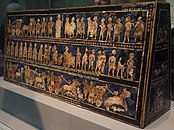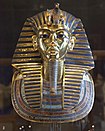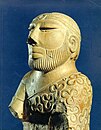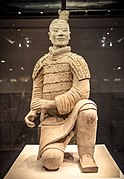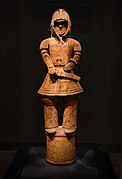مێژووی دێرین
بەشی دەستپێکی ئەم وتارە لەوانەیە زۆر درێژ بێت. (شوباتی ٢٠٢٣) |
مێژووی دێرین دەگەڕێتەوە بۆ ڕووداوەکانی ڕابردوو،[١] لە سەرەتای دەستپێکی نووسین و تۆمارەکانی مێژووی مرۆڤ. دەستواژەکە دەکرێت بەکاربھێنرێت بۆ ئاماژەدان بە کاتێکی دیاریکراو یان ڕێکخراوە ئەکادیمییەکان. لێکۆلینەوە ئەکادیمییەکان لەسەر مێژویی دێرین دەکرێت زانستی بێت یان دێرینەناسی بێت، بە لێکۆلینەوە کردن لەسەر کەلوپەلە بەڵگە لەسەربووەکان یان مێژووی مرۆڤیی (لێکۆلینەوە لەسەر مێژوو بەناو دەقەکان، شیعر و زمانەوانی)
تۆماری ڕابردوو بەتەواوی بەناو ٥،٠٠٠ ساڵدا تێپەردەبێت، لە سەردەمی نووسینی بزمارییەوە دەست پێدەکات، لەگەڵ کۆنترین دەق و نووسینەکانی نزیک ٢٦٠٠ ساڵی پێش زایین.[٢] مێژووی دێرین تەواوی ئەو کیشوەرانە دەگەرێتەوە کە مرۆڤەکان لێی نیشتەجێبوون لە سەردەمی ٣٠٠ ھەزار ساڵ پێش زایین تاوەکوو ٥٠٠ی زایینی. سیستمی سێ-سەردەمی ساتی دێرین سیستمی سێ-سەردەمەکە دەکاتە ھەرسێ سەردەمی بەردین، برۆنز، ئاسن مێژووی تۆمارکراو وادانراوە لە سەردەمی برۆنزەوە دەستپێبکات.[٣] دەستپێک و کۆتایی سەردەمەکان جیاوازی ھەیە لەنێوان ناوچەکانی جیھان، لە زۆربەی ناوچەکان سەردەمی برۆنز بە گشتی وا دانراوە کە لە پاش چەن سەدەیەک دوای ساڵی ٣٠٠٠ی پێش زایین دەستپێبکات[٤] لەکاتێکدا کۆتایی سەردەمی ئاسن لە سەرەتای ھەزارەی یەکەمی پێش زایینە لە ھەنێک لە ناوچەکان، و لە کۆتایی کۆتایی ھەزارەی یەکەمی زاینییە بۆ ھەنێکی تر.
ئەگەرچی ڕێکەوتی کۆتایی ھاتنی سەردەمی دێرین ناکۆکی لەسەرە، ھەنێک لە زاناکانی ڕۆژاوا کەوتنی ئیمپراتۆریەتیی ڕۆمانی لە ٤٧٤ی زاینیی) (کە زۆر بەکاردێت)[٥][٦]، نزیکی ئەکادیمیای ئەفلاتوونی لە ٥٢٩ی زایینی[٧] مردنی جەستێنیانی یەکەم لە ٥٦٥ی زایینی[٨] ھاتنی ئایینی ئیسلام[٩] ھەڵکشانی و بەھێزبوونی شارلمان[١٠] وەک کۆتایی مێژوویی دێرین و مێژوویی کلاسیکی ئەورووپی بەکاردەھێنن.
لە کاتی سەردەمی مێژووی دێرین (کە بە زۆری لە ٣٠٠٠ی پێش زایینەوە دەست پێ دەکات)، ڕیژەی دانیشتووانی جیھان بە شێوەیەکی خێرا گەشەی دەسەند بەھۆی بەھۆی شۆڕشی کشتووکاڵی، کە لە پەرەسەندنێکی تەواو دابوو، بەگوێرەی HYDE کە لە ھۆڵەندا ھەژمارکراوە، ڕێژەیش دانیشتووانی بە خێرایی زیادی کردووە لەم سەردەمە. لە ١٠،٠٠٠ی پێش زایین لە پێش مێژوو، ڕێژەیش دانیشتووانی جیھان لە دوو ملیۆن کەس، بەرز بوویەوە بۆ ٤٥ ملیۆن بە ھاتنی ٣،٠٠٠ی پێش زایین. بە ھاتن و تێپەربوونی سەردەمی ئاسن لە ١،٠٠٠ی پێش زایین، ڕێژەی دانیشتووانی جیھان زیاد بووە بۆ ٧٢ ملیۆن کەس. لە کۆتایی ٥٠٠ی پێش زایین، ڕێژەی دانیشتووان وا بیرکراوەتەوە کە گەیشت بێت بە ٢٠٩ ملیۆن کەس. لە ١٠،٥٠٠ ساڵدا ڕیژەی دانیشتووان ١٠٠ ئەوەندە زیادبووە.[١١]
سەرچاوەکان
[دەستکاری]- ^ WordNet Search – 3.0, "History" 2005-09-17 لە وەیبەک مەشین ئەرشیڤ کراوە.
- ^ See also The Origin and Development of the Cuneiform System of Writing, Samuel Noah Kramer, Thirty Nine Firsts In Recorded History, pp. 381–383.
- ^ Kipfer, Barbara Ann (30 April 2000). Encyclopedic Dictionary of Archaeology. New York: Springer Science & Business Media (published 2000). p. 564. ISBN 9780306461583. Retrieved 29 January 2021.
Three-Age system: The division of human prehistory into three successive stages - Stone Age, Bronze Age, and Iron Age - based on the main type of material used in tools of the period. [...] The Ages are only developmental stages, and some areas skipped one or more of the stages. At first entirely hypothetical, these divisions were later confirmed by archaeological observations.
- ^ Eric H. Cline (2 February 2021). 1177 B.C.: The Year Civilization Collapsed: Revised and Updated. Princeton University Press. p. xv. ISBN 978-0-691-20801-5. OCLC 1193069840.
- ^ Clare, I.S. (1906). Library of universal history: containing a record of the human race from the earliest historical period to the present time; embracing a general survey of the progress of mankind in national and social life, civil government, religion, literature, science, and art. New York: Union Book. p. 1519 (cf., Ancient history, as we have already seen, ended with the fall of the Western Roman Empire; [...])
- ^ United Center for Research and Training in History. (1973). Bulgarian historical review. Sofia: Pub. House of the Bulgarian Academy of Sciences. p. 43. (cf. ... in the history of Europe, which marks both the end of ancient history and the beginning of the Middle Ages, is the fall of the Western Roman Empire.)
- ^ Hadas, Moses (1950). A History of Greek Literature. Columbia University Press. p. 273. ISBN 978-0-231-01767-1.
- ^ Robinson, C.A. (1951). Ancient History from Prehistoric Times to the Death of Justinian. New York: Macmillan.
- ^ Breasted, J.H. (1916). Ancient Times, a History of the Early World: An Introduction to the Study of Ancient History and the Career of Early Man. Boston: Ginn and Company.
- ^ Myers, P.V.N. (1916). Ancient History. New York [etc.]: Ginn and company.
- ^ Data 2019-12-10 لە وەیبەک مەشین ئەرشیڤ کراوە. from History Database of the Global Environment. 2018-02-27 لە وەیبەک مەشین ئەرشیڤ کراوە. K. Klein Goldewijk, A. Beusen and P. Janssen, "HYDE 3.1: Long-term dynamic modeling of global population and built-up area in a spatially explicit way", from table on p. 2, Netherlands Environmental Assessment Agency (MNP), Bilthoven, The Netherlands.
| کۆمنزی ویکیمیدیا، میدیای پەیوەندیدار بە مێژووی دێرین تێدایە. |

